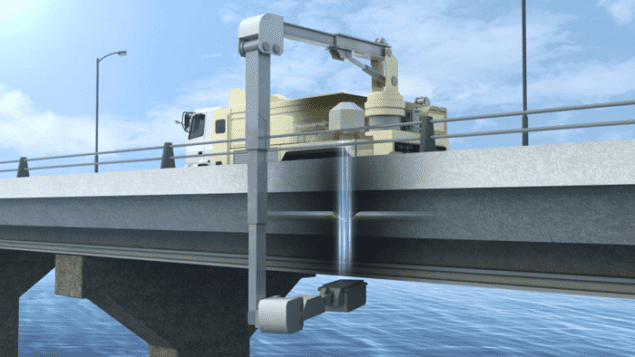
A compact neutron source has been used to quickly and non-destructively measure the amount of salt inside pieces of concrete. The technique was developed by Yoshie Otake and colleagues at RIKEN in Japan and could help assess salt damage in the world’s ageing civil infrastructure.
Concrete reinforced with steel beams is a key component of bridges, tunnels and other civil infrastructure; and therefore maintaining its integrity is an important task worldwide. As reinforced concrete ages, the steel beams can corrode as salt penetrates the material. This is a significant problem in coastal regions, where salt is present in sea spray, and also in places where salt is used to melt ice on roads and walkways. Salt incursion is a particular problem in Japan because of the country’s densely populated coastline and temperate climate. Japanese engineers are therefore very keen to determine when salt corrosion exceeds safe legal limits so that structures can be repaired or replaced.
Streamlined process
Current methods for corrosion inspection involve boring out core samples from concrete – which is a time-consuming and potentially destructive process. To streamline the inspection process, Otake’s team has developed a technique that uses a neutron beam to measure the salt content inside concrete. Because it is non-destructive, the technique can monitor changes in salt content over time without the need to bore more and more holes.
Otake and colleagues made their measurements using the RIKEN’s Accelerator-driven Compact Neutron Source (RANS), which produces a neutron beam by bombarding a beryllium target with 7 MeV protons. These neutrons emerge at high speeds and are then slowed-down (or themalized) by passing them through a polyethylene moderator.

Bringing neutrons into the steel industry
Neutrons are an ideal probe of concrete because they can travel deep into the material with relative ease. Occasionally, however, neutrons will interact with atomic nuclei in the concrete creating gamma rays that can then escape.
The RIKEN researchers use high-resolution germanium detectors to measure the energy distribution of these gamma-rays, looking for the distinctive energy peaks associated with the chlorine nuclei in salt. They tested the technique by sandwiching salt between concrete slabs and trying to detect it. In just 10 min, the team determined the salt content of regions surrounded by up to 18 cm of concrete.
“Our feasibility study has shown that neutron beams can indeed be used to measure whether the salt content of a concrete structure is within the legal limits set by the government,” says Otake. However, the technique cannot currently be used in the field because RANS is too large to move. “Our next challenge is to build a compact neutron source that is small enough to be readily transported to various infrastructures to conduct measurements”.
- There is much more about the scientific and commercial uses of neutrons in this Physics World Focus on Neutron Science.



